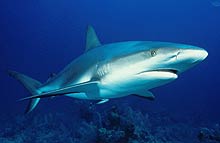According to the public version of the story, this ancestral being began his journey along the coast of northeast Arnhem Land. While sleeping on the beach, Mä na was speared by an ancestor from another clan who did not want other creator beings near him. Enraged by this stealthy attack, Mä na charged inland from the sea, exploding into the landscape.
The ancestral shark gouged his way inland using his teeth to carve out several river systems. As he journeyed onward, his teeth broke off on the hard riverbanks; these lost teeth became the pandanus trees that line rivers today. The leaves of these trees are dagger-shaped with serrated edges, like shark teeth. These trees represent both Mä na’s anger at being speared and the stingray-spine tipped spear that Mä na carried to avenge his death. |

Whaler shark
(© Andrea Marshall) |
